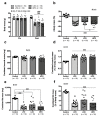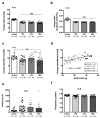Caloric Restriction per se Rather Than Dietary Macronutrient Distribution Plays a Primary Role in Metabolic Health and Body Composition Improvements in Obese Mice
- PMID: 34578880
- PMCID: PMC8466799
- DOI: 10.3390/nu13093004
Caloric Restriction per se Rather Than Dietary Macronutrient Distribution Plays a Primary Role in Metabolic Health and Body Composition Improvements in Obese Mice
Abstract
Caloric restriction (CR) is of key importance in combating obesity and its associated diseases. We aimed to examine effects of dietary macronutrient distribution on weight loss and metabolic health in obese mice exposed to CR. Male C57BL/6J mice underwent diet-induced obesity for 18 weeks. Thereafter mice were exposed to a 6-week CR for up to 40% on either low-fat diet (LFD; 20, 60, 20% kcal from protein, carbohydrate, fat), low-carb diet (LCD; 20, 20, 60% kcal, respectively) or high-pro diet (HPD; 35, 35, 30% kcal, respectively) (n = 16 each). Ten mice on the obesogenic diet served as age-matched controls. Body composition was evaluated by tissue dissections. Glucose tolerance, bloods lipids and energy metabolism were measured. CR-induced weight loss was similar for LFD and LCD while HPD was associated with a greater weight loss than LCD. The diet groups did not differ from obese controls in hindlimb muscle mass, but showed a substantial decrease in body fat without differences between them. Glucose tolerance and blood total cholesterol were weight-loss dependent and mostly improved in LFD and HPD groups during CR. Blood triacylglycerol was lowered only in LCD group compared to obese controls. Thus, CR rather than macronutrient distribution in the diet plays the major role for improvements in body composition and glucose control in obese mice. Low-carbohydrate-high-fat diet more successfully reduces triacylglycerol but not cholesterol levels compared to isocaloric high-carbohydrate-low-fat weight loss diets.
Keywords: diets; high-protein; low-carbohydrate; low-fat; weight loss.
Conflict of interest statement
The authors declare no conflict of interest.
Figures



Similar articles
-
Hypocaloric Low-Carbohydrate and Low-Fat Diets with Fixed Protein Lead to Similar Health Outcomes in Obese Mice.Obesity (Silver Spring). 2020 Aug;28(8):1494-1502. doi: 10.1002/oby.22872. Epub 2020 Jul 8. Obesity (Silver Spring). 2020. PMID: 32639096
-
At similar weight loss, dietary composition determines the degree of glycemic improvement in diet-induced obese C57BL/6 mice.PLoS One. 2018 Jul 23;13(7):e0200779. doi: 10.1371/journal.pone.0200779. eCollection 2018. PLoS One. 2018. PMID: 30036374 Free PMC article.
-
Fatty acid desaturase regulation in adipose tissue by dietary composition is independent of weight loss and is correlated with the plasma triacylglycerol response.Am J Clin Nutr. 2007 Sep;86(3):759-67. doi: 10.1093/ajcn/86.3.759. Am J Clin Nutr. 2007. PMID: 17823443 Clinical Trial.
-
Carbohydrate for weight and metabolic control: where do we stand?Nutrition. 2010 Feb;26(2):141-5. doi: 10.1016/j.nut.2009.07.002. Nutrition. 2010. PMID: 20122538 Review.
-
Low-carbohydrate diets cause obesity, low-carbohydrate diets reverse obesity: a metabolic mechanism resolving the paradox.Appetite. 2007 Mar;48(2):135-8. doi: 10.1016/j.appet.2006.06.007. Epub 2006 Dec 1. Appetite. 2007. PMID: 17141367 Free PMC article. Review.
Cited by
-
Effects of Diet Macronutrient Composition on Weight Loss during Caloric Restriction and Subsequent Weight Regain during Refeeding in Aging Mice.Nutrients. 2023 Nov 19;15(22):4836. doi: 10.3390/nu15224836. Nutrients. 2023. PMID: 38004232 Free PMC article.
References
-
- The Global BMI Mortality Collaboration. Di Angelantonio E., Bhupathiraju S.N., Wormser D., Gao P., Kaptoge S., de Gonzalez A.B., Cairns B., Huxley R., Jackson C., et al. Body-mass index and all-cause mortality: Individual-participant-data meta-analysis of 239 prospective studies in four continents. Lancet. 2016;388:776–786. doi: 10.1016/S0140-6736(16)30175-1. - DOI - PMC - PubMed
-
- National Task Force on the Prevention and Treatment of Obesity. Billington C.J., Epstein L.H., Goodwin N.J., Hill J.O., Pi-Sunyer F.X., Rolls B.J., Stern J., Wadden T.A., Weinsier R.L., et al. Overweight, obesity, and health risk. Arch. Intern. Med. 2000;160:898–904. doi: 10.1001/archinte.160.7.898. - DOI - PubMed
MeSH terms
Substances
LinkOut - more resources
Full Text Sources
Medical

